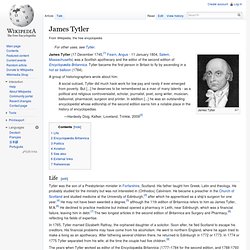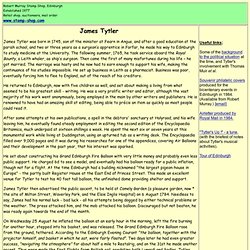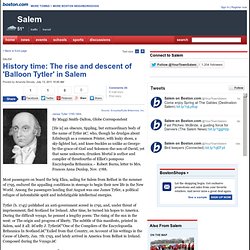

The Big Sky. Jamie Tytler wis a funny wee earnest sort o man. He aye luiket tired, like he could dae wi a guid nicht's sleep. Likely he nivver had mony o them, fer he wisnae the maist successfu o businessmen, an he wis aye runnin fae his creditors. He cam doon tae Embra fae his hame up north in Angus tae study the medicine, tried tae mak it as ship's surgeon oan the whalers, an endit up in a pharmacy business in Leith. That didnae work oot weel, an he ran aff tae England wi his wifie an bairns in tow.
James Tytler. James Tytler James Tytler (17 December 1745,[1] Fearn, Angus - 11 January 1804, Salem, Massachusetts) was a Scottish apothecary and the editor of the second edition of Encyclopædia Britannica.

Tytler became the first person in Britain to fly by ascending in a hot air balloon (1784). A group of historiographers wrote about him: A social outcast, Tytler did much hack work for low pay and rarely if ever emerged from poverty. James Tytler and the Grand Edinburgh Fire Balloon. James "Balloon" Tytler was a spectacular Jack-of-all-trades - surgeon, writer, publisher, composer, and poet - but his claim to fame is rooted firmly in the day he made aviation history.

The "Grand Edinburgh Fire Balloon", which he invented, created a great deal of excitement in 1784 and ultimately resulted in Britain's first manned aerial ascent. Tytler was an eccentric and luckless character, described by Burns as an "obscure, tippling though extraordinary body", and both his epic flight and his other great achievement - the eight years he spent compiling the 10-volume second edition of the Encyclopaedia Britannica - are both largely overlooked.
James Tytler, Britain's First Aeronaut. James Tytler James Tytler was born in 1745, son of the minister at Fearn in Angus, and after a good education at the parish school, and two or three years as a surgeon’s apprentice in Forfar, he made his way to Edinburgh to study medicine at the University.

The following summer, 1765, he took service aboard the Royal Bounty, a Leith whaler, as ship’s surgeon. Then came the first of many misfortunes during his life – he got married. The marriage was hasty and he now had to earn enough to support his wife, making the continuance of his studies impossible. He set up business in Leith as a pharmacist. He returned to Edinburgh, now with five children as well, and set about making a living from what seemed to be his greatest skill - writing. He set about constructing his Grand Edinburgh Fire Balloon with very little money and probably even less public support. Www.scuilwab.org.uk/assets/FlightinScotland.pdf.
History time: The rise and descent of 'Balloon Tytler' in Salem - Salem - Your Town. Source: Encyclopædia Britannica, Inc.

James Tytler 1745-1804. By Maggi Smith-Dalton, Globe Correspondent[He is] an obscure, tippling, but extraordinary body of the name of Tytler … who, though he drudges about Edinburgh as a common Printer, with leaky shoes, a sky-lighted hat, and knee-buckles as unlike as George-by-the-grace-of-God and Solomon-the-son-of-David, yet that same unknown, drunken Mortal is author and compiler of threefourths of Elliot's pompous Encyclopedia Britannica.~ Robert Burns, letter to Mrs. Frances Anna Dunlop, Nov. 1788. Most passengers on board the brig Eliza, sailing for Salem from Belfast in the summer of 1795, endured the appalling conditions in steerage to begin their new life in the New World.
Among the passengers landing that August was one James Tytler, a political refugee of indomitable spirit and indefatigable intellectual energies. Overview of James Tytler. Www.scotair.com/Tytler and Lunardi.pdf. Siol nan Gaidheal - Scotland's First Aviator? Standing on a corner of a quiet back road running out of the village of Ceres in Fife is a stone bearing an unusual plaque.

This commemorates the aerial exploits of one Vincenzo Lunardi, an Italian aeronaut who, it is claimed, made the first ascent by hydrogen balloon in Scotland on the 5th October 1785, traveling 46 miles from Edinburgh to Fife. So states the plaque, but a little research shows that he was, in fact, only the second man to do so. The first was a native Scot about whom very little is nowadays known, one James Tytler. Lunardi is the better known of the two because of his flamboyance and the fact that he made a career out of balloon ascents for several years. He had come to Scotland following several successes in England, and proceeded to fly two or three times from his base in Edinburgh, plus a couple of flights from Glasgow and Kelso. The plaque near Ceres.